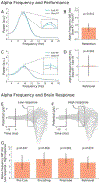The frequency of alpha oscillations: Task-dependent modulation and its functional significance
- PMID: 30176369
- PMCID: PMC6197916
- DOI: 10.1016/j.neuroimage.2018.08.063
The frequency of alpha oscillations: Task-dependent modulation and its functional significance
Abstract
Power (amplitude) and frequency are two important characteristics of EEG alpha oscillations (8-12 Hz). There is an extensive literature showing that alpha power can be modulated in a goal-oriented manner to either enhance or suppress sensory information processing. Only a few studies to date have examined the task-dependent modulation of alpha frequency. Instead, alpha frequency is often viewed as a trait variable, and used to characterize individual differences in cognitive functioning. We performed two experiments to examine the task-dependent modulation of alpha frequency and its functional significance. In the first experiment, high-density EEG was recorded from 21 participants performing a Sternberg working memory task. The results showed that: (1) during memory encoding, alpha frequency decreased with increasing memory load, whereas during memory retention and retrieval, alpha frequency increased with increasing memory load, (2) higher alpha frequency prior to the onset of probe was associated with longer reaction time, and (3) higher alpha frequency prior to the onset of cue or probe was associated with weaker early cue-evoked or probe-evoked neural responses. In the second experiment, simultaneous EEG-fMRI was recorded from 59 participants during resting state. An EEG-informed fMRI analysis revealed that the spontaneous fluctuations of alpha frequency, but not alpha power, were inversely associated with BOLD activity in the visual cortex. Taken together, these findings suggest that alpha frequency is task-dependent, may serve as an indicator of cortical excitability, and along with alpha power, provides more comprehensive indexing of sensory gating.
Keywords: Alpha frequency; Alpha modulation; Alpha oscillation; Alpha power; Alpha source; Simultaneous EEG-fMRI; Working memory.
Copyright © 2018 Elsevier Inc. All rights reserved.
Conflict of interest statement
Disclosure of Interest: The authors report no conflicts of interest.
Figures





Similar articles
-
Individual differences in EEG theta and alpha dynamics during working memory correlate with fMRI responses across subjects.Clin Neurophysiol. 2007 Nov;118(11):2419-36. doi: 10.1016/j.clinph.2007.07.023. Epub 2007 Sep 27. Clin Neurophysiol. 2007. PMID: 17900976 Free PMC article.
-
Developmental changes of BOLD signal correlations with global human EEG power and synchronization during working memory.PLoS One. 2012;7(7):e39447. doi: 10.1371/journal.pone.0039447. Epub 2012 Jul 6. PLoS One. 2012. PMID: 22792176 Free PMC article.
-
The roles of alpha oscillation in working memory retention.Brain Behav. 2019 Apr;9(4):e01263. doi: 10.1002/brb3.1263. Epub 2019 Mar 19. Brain Behav. 2019. PMID: 30887701 Free PMC article.
-
Functional Magnetic Resonance Imaging Methods.Neuropsychol Rev. 2015 Sep;25(3):289-313. doi: 10.1007/s11065-015-9294-9. Epub 2015 Aug 7. Neuropsychol Rev. 2015. PMID: 26248581 Free PMC article. Review.
-
Human memory retention and recall processes. A review of EEG and fMRI studies.Neurosciences (Riyadh). 2013 Oct;18(4):330-44. Neurosciences (Riyadh). 2013. PMID: 24141456 Review.
Cited by
-
Peak occipital alpha frequency mediates the relationship between sporting expertise and multiple object tracking performance.Brain Behav. 2024 Feb;14(2):e3434. doi: 10.1002/brb3.3434. Brain Behav. 2024. PMID: 38383037 Free PMC article.
-
Cognitive and emotional regulation processes of spontaneous facial self-touch are activated in the first milliseconds of touch: Replication of previous EEG findings and further insights.Cogn Affect Behav Neurosci. 2022 Oct;22(5):984-1000. doi: 10.3758/s13415-022-00983-4. Epub 2022 Feb 19. Cogn Affect Behav Neurosci. 2022. PMID: 35182383 Free PMC article.
-
Frequency modulation of cortical rhythmicity governs behavioral variability, excitability and synchrony of neurons in the visual cortex.Sci Rep. 2022 Dec 3;12(1):20914. doi: 10.1038/s41598-022-25264-5. Sci Rep. 2022. PMID: 36463385 Free PMC article.
-
Atypical Temporal Dynamics of Resting State Shapes Stimulus-Evoked Activity in Depression-An EEG Study on Rest-Stimulus Interaction.Front Psychiatry. 2019 Oct 15;10:719. doi: 10.3389/fpsyt.2019.00719. eCollection 2019. Front Psychiatry. 2019. PMID: 31681034 Free PMC article.
-
Brain Oscillations and Autonomic Synthonization via Comodulation in Collaborative Negotiation.Entropy (Basel). 2025 Aug 18;27(8):873. doi: 10.3390/e27080873. Entropy (Basel). 2025. PMID: 40870346 Free PMC article.
References
-
- Anderson KL, & Ding M (2011). Attentional modulation of the somatosensory mu rhythm. Neuroscience, 180, 165–180. - PubMed
-
- Anokhin A, & Vogel F (1996). EEG alpha rhythm frequency and intelligence in normal adults. Intelligence, 23(1), 1–14.
-
- Bernhard CG, & Skoglund CR (1939). On the Alpha Frequency of Human Brain Potentials as a Function of Age1. Skandinavisches Archiv Für Physiologie, 82(2), 178–184. 10.1111/j.1748-1716.1939.tb00458.x - DOI
Publication types
MeSH terms
Grants and funding
LinkOut - more resources
Full Text Sources
Other Literature Sources

